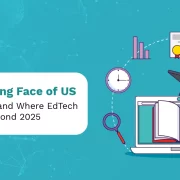
PDFs 2.0: The Rise of Smart Remediation with AI and Automation
The PDF, originally a groundbreaking document format, has evolved into the digital backbone of contemporary society. From contracts and reports to presentations and ebooks, PDFs power information exchange across industries and continents. However, their accessibility often remains a hurdle, excluding individuals with disabilities and hindering information flow.
As per World Health Organization data, there are over 1 billion, which accounts for 15% of the global population, who suffer from disabilities. Now this is where smart remediation comes in: a new way to make PDFs accessible that uses the power of artificial intelligence (AI).
Smart remediation makes sure that truly inclusive documents are made by automating document remediation. This breaks down barriers and makes the digital world more approachable.
Table of Contents:
- The Evolution of PDFs: From Static to Smart
- Smart Remediation: A New Era for PDFs
- Top Five Benefits of Smart Remediation to Explore
- Five Best Practices for PDF Remediation
- AI-Driven Personalization: The Next Step in Intelligent Remediation
- Conclusion
The Evolution of PDFs: From Static to Smart
Originally offering security and mobility, the Portable Document Format (PDF) has become the accepted norm for digital documents. For people with disabilities, PDFs do, however, often provide significant access problems.
For those using screen readers or assistive technology, complex layouts, embedded images, and a lack of alt text can make the material inaccessible.
Several international standards define accessibility and PDF Remediation best practices. The most widely recognized is the Web Content Accessibility Guidelines (WCAG) by the World Wide Web Consortium (W3C). WCAG 2.1 outlines specific criteria for making web content, including PDFs, accessible to everyone.
Also Read: The Ultimate Checklist for PDF Accessibility: Tips, Tools, and Standards
Smart Remediation: A New Era for PDFs
The global market for digital accessibility solutions is expected to reach $769.5 million by 2028. This shows that more and more people want accessible information, which shows how important it is to have good solutions like smart remediation.
Here’s what makes smart remediation a game-changer:
1. AI-Driven Accessibility
At the heart of smart remediation lies AI-powered document analysis. AI algorithms can intelligently identify accessibility issues like missing alt text, incorrect heading structures, and color contrast violations. This eliminates the need for manual inspection, saving time and resources. Automated document remediation can save up to 80% of document processing time.
2. Automation in Document Accessibility
Once AI identifies issues, automation takes over. Remediation tools automatically fix these errors, generating accessible versions of the original PDF. This means making sure there is enough color contrast, adding alt text to images, and making sure the layout makes sense with headings and lists.
3. Cost-Effectiveness
The automated nature of smart remediation translates into reduced manual efforts and associated costs. As the demand for accessibility solutions grows, a cost-effective approach becomes paramount for widespread adoption.
Top Five Benefits of Smart Remediation to Explore
Smart remediation leverages AI and automation to transform PDF accessibility. AI algorithms automatically identify and fix common issues like missing alt text, incorrect headings, and color contrast violations.
They analyze complex layouts and apply appropriate techniques, learning and adapting over time for increased accuracy. This translates to numerous benefits: faster turnaround times, reduced costs, improved user experience, and, most importantly, consistent PDF accessibility compliance.
Below are the advantages of smart remediation:
1. Increased Accessibility
Accessible PDFs ensure everyone can access information equally, promoting inclusivity and compliance with PDF accessibility standards like WCAG 2.1. This way, organizations align with global accessibility benchmarks, fostering an environment where information is universally accessible.
2. Enhanced User Experience
Accessible documents are easier for everyone, of any ability, to read and access, which makes the user experience better. In addition, this better user experience leads to more engagement, happiness, and loyalty.
3. Improved Efficiency
Automation significantly reduces the time and effort required for PDF remediation, freeing up resources for other tasks.
As per McKinsey data, automation leads to a 30-50% reduction in time spent on document-related tasks. This reduction in time expenditure translates to increased operational efficiency and allows organizations to focus on strategic initiatives.
4. Reduced Costs
Smart remediation brings about substantial cost savings by minimizing the need for manual intervention. Automation not only reduces labor costs but also mitigates the risk of errors that might incur additional expenses in the remediation process.
5. Future-Proofed Documents
The adaptive nature of AI algorithms ensures that smartly remediated PDFs remain compatible with emerging technologies and evolving accessibility standards. This future-proofing eliminates the need for frequent updates or overhauls, providing a sustainable and long-term solution for document accessibility.
Five Best Practices for PDF Remediation
While AI automates much of the heavy lifting, human expertise remains crucial. Prioritize the user experience, choosing solutions that create user-friendly and engaging documents. Opt for reputable vendors with expertise in AI-powered accessibility and ethical development.
Lastly, stay updated on evolving accessibility standards and best practices to ensure your PDFs remain truly inclusive for everyone.
Hence, even with smart remediation, best practices remain crucial:
1. Prioritize User Experience
Accessibility isn’t just about technical compliance; it’s about creating documents that are truly usable for everyone. Consider factors like:
- Navigation: Ensure clear and logical document structure with accessible headings, bookmarks, and navigation tools.
- Fonts and Colors: Use accessible fonts with good contrast and avoid problematic color combinations.
- Alternative Text: Provide meaningful descriptions for all images, charts, and other non-text content.
- Interactive Elements: Ensure keyboard accessibility for interactive elements like buttons and links.
2. Choose the Right Tools
Explore AI-powered document accessibility solutions that cater to the specific needs of your organization.
Choose one that offers:
- Customizable rules and settings to tailor remediation to your specific needs.
- Human-in-the-loop options for complex documents or specific accessibility requirements.
- Reporting and analytics to track progress and identify areas for improvement.
3. Integrate Accessibility into Your Workflow
Don’t wait until the end to remediate PDFs. Integrate accessibility checks and best practices into your content creation process:
- Use accessible authoring tools like Microsoft Word with accessibility features enabled.
- Train content creators on accessibility guidelines and best practices.
- Perform regular audits to identify and fix issues early on.
4. Stay Informed and Up-to-Date
Accessibility standards and best practices evolve.
Stay updated by:
- Following accessibility organizations like W3C and WAI-ARIA.
- Subscribing to industry newsletters and blogs.
- Attending accessibility conferences and workshops.
5. Partner with Accessibility Experts
While AI tools are powerful, complex documents or specific user needs may require human expertise. Partner with accessibility specialists to:
- Develop a comprehensive accessibility strategy.
- Review and audit the remediated documents for accuracy.
- Provide ongoing support and training.
Also Read: ADA Compliance 101: What You Need to Know and How to Achieve It
AI-Driven Personalization: The Next Step in Intelligent Remediation
The integration of Artificial Intelligence (AI) into document remediation has been revolutionary, yet the possibilities for personalization in accessibility solutions are just starting to emerge.
As businesses and organizations respond to a growing variety of user needs, intelligent remediation is advancing to deliver customized experiences for diverse audiences, including those with specific disabilities.
1. What is Personalization in Smart Remediation?
Personalization in smart remediation highlights how AI-powered systems can modify accessibility features to meet the specific needs of each end user. This approach transcends universal compliance standards such as WCAG 2.1 by tackling challenges that are unique to each user. For example:
- Those with vision problems can view PDFs designed for screen readers with accurate alt text and well-structured navigation systems.
- For those with neurodivergent disorders, cognitive accessibility elements—simplified layouts and enhanced readability—can be tailored.
2. How Can RPA 2.0 Improve Smart Remediation?
RPA 2.0 automates time-consuming, repetitive operations such as content tagging, data structure, and layout optimization, so transforming document remedial action.
Unlike earlier automation technologies, RPA 2.0 dynamically adapts to complex document formats, providing accessibility with minimal human participation.
Key features of RPA 2.0 in intelligent remediation include:
- Dynamic Adaptability: Adjusts to distinct document layouts and content variations
- Error Reduction: Minimizes manual errors, ensuring consistent compliance
- Scalability: Empowers organizations to manage and address large volumes of documents effectively
3. ADA Document Remediation for Individualized Compliance
Meeting ADA standards establishes essential accessibility, but the shift toward personalized ADA document remediation enhances inclusivity even further. Documents can be crafted to provide:
- Low-vision or dyslexic users can alter the text size and spacing.
- Multilingual assistance serves both native speakers and multilingual users.
- Interactive components support many different kinds of assistive tools.
4. Key Benefits of AI-Driven Personalization
Using AI-driven tailoring in smart remediation meets the specific needs of different users, ensuring compliance and improving their overall experience.
- Boosted User Interaction: By catering to individual user needs, personalized smart remediation elevates satisfaction and usability.
- Broader Reach: Customized documents enhance accessibility for a larger audience, including those with unique or intricate disabilities.
- Dynamic Adaptability: AI-driven personalization keeps documents relevant and valuable, adapting to changing user preferences.
- Regulatory Leadership: Organizations that adopt personalized remediation not only meet compliance standards but also establish new benchmarks for excellence in accessibility.
Conclusion
The future of PDFs is inclusive by design. Exploring this future and guaranteeing information availability for everyone depends on smart remedial action with artificial intelligence and automation. Accepting this technology will help us to empower people with disabilities, promote cooperation, and create a more fair digital environment.
Work with Hurix Digital to investigate its creative AI-powered document access technologies. From automated remedial tools to professional human advice, we provide a spectrum of services to enable you to produce PDFs that are not only technically accessible but also inclusive and user-friendly.
Speak with us now to start your path toward a more easily available digital future.

Vice President – Digital Content Transformation. He is PMP, CSM, and CPACC certified and has 20+ years of experience in Project Management, Delivery Management, and managing the Offshore Development Centre (ODC).





